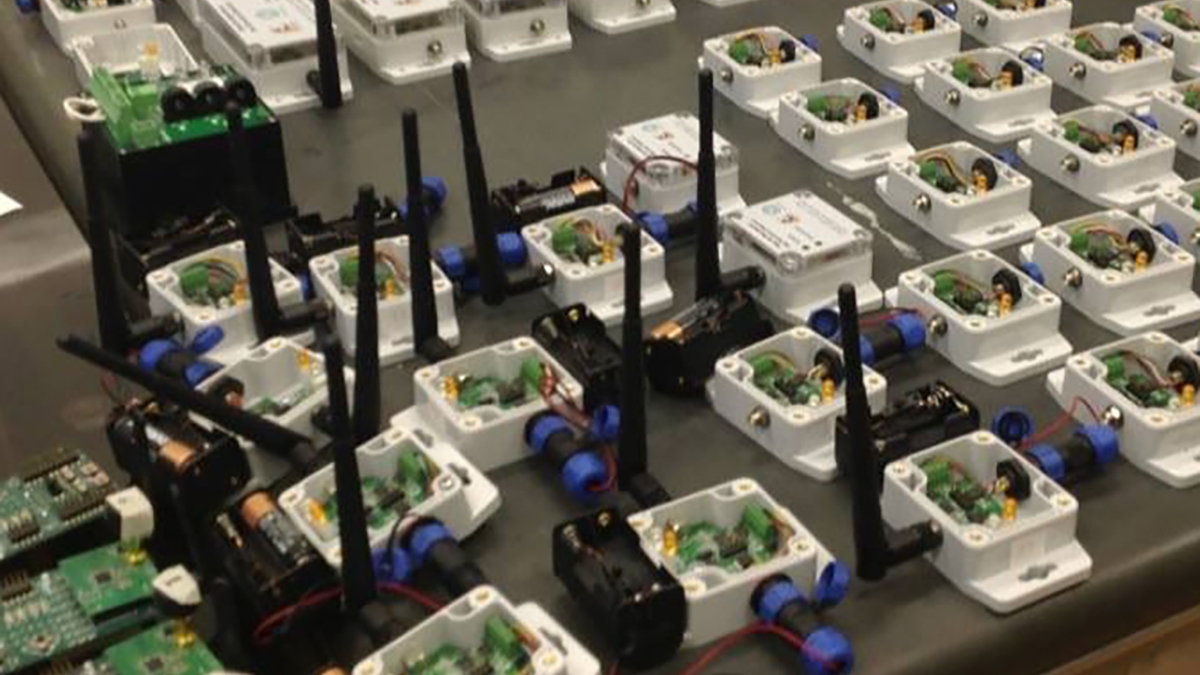Meeting digital world challenges

Embedded sensor circuits and transceivers from the ITESM Center for Electronics and Telecommunications Laboratory.
The International Sensors, Signal Processing and Communications Workshop, held last month at Arizona State University, brought together government, industry and academic leaders from the United States and Mexico to share new signal/information processing research and identify collaborations that can meet the challenges of an increasingly digital world.
The workshop is a collaborative initiative between the Sensor, Signal and Information Processing (SenSIP) Research Center in the School of Electrical, Computer and Energy Engineering in the Ira A. Fulton Schools of Engineering and the Tecnológico de Monterrey (ITESM) Center for Electronics and Telecommunications.
“Forecasts for sensor demand are as high as 100 trillion by 2030,” said plenary speaker Stephen Whalley, chief strategy officer, MEMS Industry Group (MIG). “The future Internet of Everything/Things landscape will require deployment of printed electronics, antennas, power sources, transistors and sensors to enable multiple orders of magnitude cost reduction per square meter. Stretchable plastic and thin film substrates and ultimately roll-to-roll printing on paper will serve various application, cost, performance and form factor needs.”
The two-day workshop included presentations from the Greater Phoenix Economic Council, IBM T. J. Watson Research Center, Lawrence Livermore National Laboratory, MIG, NXP Semiconductor, Prairie View A&M University and SenSIP and ITESM. SenSIP STEM project partner institutions, Clarkson University and Prairie View A&M University, also participated with presentations and posters.
Maureen Howell, director of research and strategy for GPEC, addressed connecting innovation with research and technology through collaborative consortiums that foster shared revenue returns, and Michael Stanley from NXP provided solutions for machine learning and sensor data analytics.
ASU presentations included insights about competing in international technology markets. Philip Dowd, director of intellectual assets for physical sciences at Arizona Technology Enterprises (AzTE, the intellectual property management and technology transfer organization for ASU), provided information about filing intellectual property documents with international partners, and John Mitchell, director of corporate engagement, global outreach and extended education, addressed the importance of collaboration to stay competitive amidst fast-paced technological innovation. Joelina Peck, ECEE research advancement manager, addressed setting up international industry-university proposals, and Paola Garcia-Hicks, director of Mexico and Latin America initiatives in the Office of University Affairs, presented an overview of plans for institutional relations with Mexico and, specifically, ITESM.
Framework for future ASU-ITESM initiatives
Andreas Spanias, a professor of electrical engineering and director of SenSIP, which is a National Science Foundation Industry/University Cooperative Research Center, said the workshop was a valuable opportunity to share insights on new technologies and provide a framework for future collaboration.
“The technology is moving very quickly,” he said. “Workshops like these enable us to expand our abilities to develop digital signal processing techniques for inexpensive, reusable sensors that are critical to advancing medical, energy and mobile communications systems.”
According to Spanias, SenSIP faculty is helping the ITESM Center for Electronics and Communications propose an I/UCRC consortium-like model, comparable to SenSIP, to the Consejo Nacional de Ciencia y Tecnología, known as Conacyt. Similar to the NSF in the U.S., Conacyt is in charge of promoting and setting policies for Mexico’s scientific and technological activities, granting scholarships for postgraduate studies and managing programs to encourage industry and private-sector involvement in science and technology research and development.
Since the workshop, a joint ASU-ITESM proposal has been submitted to industry for a project on sensor localization that will support collaboration between professors Cesar Vargas-Rosales, David Muñoz Rodríguez and Rafaela Villalpando Hernández from ITESM and Cihan Tepedelenlioglu and Spanias from ASU. Additional initiatives through which ASU and ITESM may exchange students and faculty have been identified.
The workshop was sponsored in part by the NSF Office of International Science and Engineering, the NSF I/UCRC Program, and the ASU SenSIP Center, with technical co-sponsorship by IEEE Phoenix Chapter.
Additional workshops for industry, government and academics, hosted by ASU in Arizona in November and by ITESM in Monterrey in March, are planned.
More Science and technology

ASU researcher part of team discovering ways to fight drug-resistant bacteria
A new study published in the Science Advances journal featuring Arizona State University researchers has found…

ASU student researchers get early, hands-on experience in engineering research
Using computer science to aid endangered species reintroduction, enhance software engineering education and improve semiconductor…

ASU professor honored with prestigious award for being a cybersecurity trailblazer
At first, he thought it was a drill.On Sept. 11, 2001, Gail-Joon Ahn sat in a conference room in Fort Meade, Maryland.…